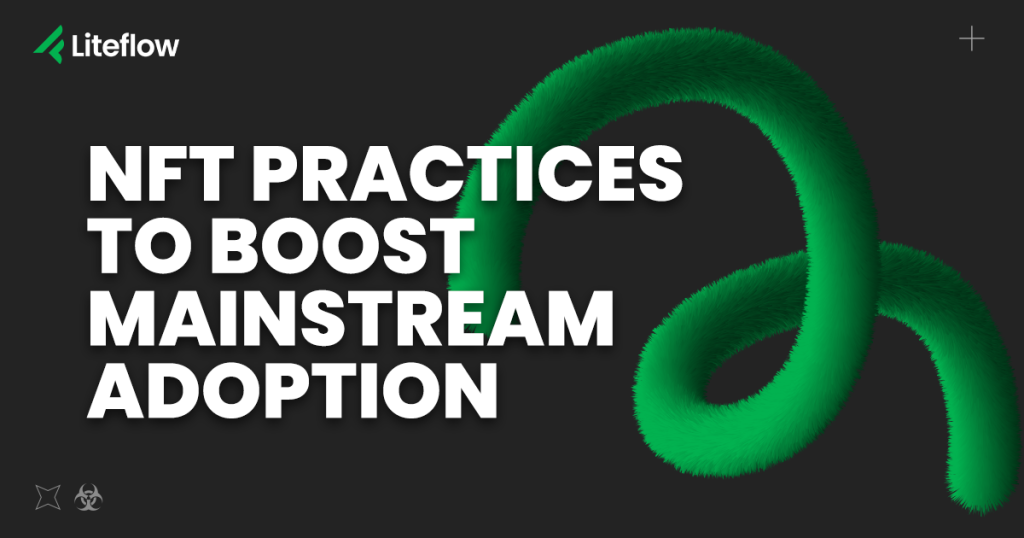NFT Practices to Boost Mainstream Adoption

Non-fungible tokens are here to stay, representing transformative potential across industries. Despite the power evident in this emerging technology, mainstream adoption is moving at a relatively slow pace. There are several reasons for a sluggish adoption rate, including regulations, questions around long-term value, and scalability concerns. Looking beyond these challenges you’ll find one of the more compelling reasons, accessibility and ease of use.
There is a steep learning curve when entering NFTs and crypto, often including hefty costs to enter the market and start exploring. This roadblock is a significant one for the average person, full of technological hurdles and financial risks. For newcomers, a big investment is required in terms of time commitment for education and knowledge growth. To learn more about creating, collecting and trading NFTs requires a fair amount of effort, something that most people don’t have time for.
NFT marketplaces, wallets and other tools are some of the most impactful components when it comes to inspiring adoption. Making these tools as accessible as possible will fast track adoption. Currently, third-party platforms don’t seem to prioritize onboarding Web3 newcomers, as UI/UXs aren’t as user friendly as they could be. To overcome this, NFT projects should be looking to incorporate accessibility tactics that can ease the learning curve and boost adoption.
Lazy Minting
Lazy minting is a method of minting a non-fungible token in which the NFT lives off-chain, only being minted when the first sale occurs. This differs from the standard minting process in that gas fees can be delayed until the time of sale because the NFT is not living on-chain until that moment. This process has its pros and cons, but it definitely helps appeal to Web3 newcomers, as the barriers to entry are reduced.
The costs associated with activity in the NFT space is a definite barrier to entry. Lazy minting reduces the friction by delaying gas fees until post-sale, enabling creators to bake the fee into their pricing and create without as much upfront cost. This eliminates deterrents to up and coming creators who might not have the budget to mint their collection the standard way.
Absorbing Mint Costs
Projects with adequate resources have an opportunity to make onboarding easier by absorbing mint costs for their community. If we really want mass adoption, this can be viewed as a responsibility of NFT projects to eliminate as many fees and points of friction as possible. There are clever ways to enable users to create and engage with NFTs without having to purchase a native currency like Ethereum, or even create a crypto wallet.
Lens protocol is a great example of a project that absorbs gas fees for their users. According to their website, “certain interfaces might use a relayer to allow “gas free” usage of the network for Lens Protocol transactions or may even subsidize part of the gas fees.” Operating on the Polygon network reduces the burden of covering these acquisition costs for users, protecting the project from excessive overhead costs and easing the onboarding process for new users.
Reddit also serves as an excellent example of how NFT infrastructure can be deployed in a user friendly fashion. The platform recently launched their “Blockchain-backed collectible avatars”, made available without the need for cryptocurrency or a crypto wallet. These NFTs were available for purchase using fiat, without the need for any blockchain understanding. This approach could very well be the best way to onboard people into the crypto ecosystem, eliminating any new processes or knowledge requirements.
Meta-Transactions
Meta transactions enable users to interact with the blockchain without requiring tokens to pay network fees. Instead of paying for gas, they only create a transaction request by signing the transaction parameters with their private key. Once signed, these parameters are sent to a secondary network, which acts as a relayer by validating the transactions if relevant to the dApp. Once validated, the relayer wraps the request into a transaction, paying the gas fee and broadcasting the transaction to the network, where it is unwrapped by being validated by the original signature and executed on behalf of the user.
By decoupling the transaction sender and the payer of gas, meta transactions represent a solution that can onboard new users into the blockchain ecosystem while simplifying processes for existing blockchain users. Meta-transactions enable a world of possibilities when it comes to scaling dApps. Gasless transactions provide practical use cases, enabling utility in smart contracts that have been limited due to gas fees and on-chain interactions.
Expanding the use of blockchain and on boarding mainstream internet users will be a constant challenge for companies in the industry. Many factors contribute to the sluggish adoption rate, but accessibility is one challenge that all projects can attempt to tackle by easing the learning curve and incorporating tactics that save user’s onboarding costs.
At Liteflow, this is something we are laser-focused on. From our lazy mint functionality to the ways we work to optimize UI/UX, we purpose build everything to be scaled into the future as adoption rises. We bring the flexibility of building Web3 projects according to your needs while helping you own your revenue model for the internet’s next era. If you’d like to explore how your Web3 project can cater to the masses, let’s bring those ideas to life! Reach out to us at Liteflow, and schedule a call with one of our experts.